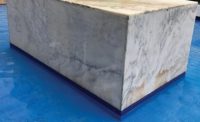Battery Park City Authority (BPCA), CTA Architects, P.C., construction manager The LiRo Group and contractor Nicholson & Galloway, Inc. have completed the $5.3 million renovation and waterproofing of the Irish Hunger Memorial. The project restored the monument, including its impressive stonework, to its former magnificence, while rendering it significantly less susceptible to damage from weather for years to come.
The Memorial, designed by internationally renowned sculptor and public artist Brian Tolle, originally opened in 2002. It is a contemplative space devoted to honor the Great Irish Hunger and Migration of 1845-1852, while encouraging viewers to contemplate present-day hunger worldwide. Over the years, it had succumbed to water infiltration from above and subsequent water damage.
The half-acre site on the corner of Vesey Street and North End Avenue, in the Battery Park City section of downtown Manhattan, overlooks the Hudson River. Visitors to the 96- x 170-foot Memorial wind through a rural Irish landscape, with paths carved into a hill thickly lined with native Irish plants and stones imported from each of Ireland’s 32 counties. The paths lead to a breathtaking viewing point 25 feet above street level, which boasts views of the Statue of Liberty and Ellis Island. Located centrally along the pathways is an authentic Irish Famine-era stone cottage that was donated to the Memorial by Tolle’s extended family, the Slacks of Attymass, County Mayo. It was disassembled and brought over from Ireland and reconstructed on-site, within the green “hillside” of the Memorial.
“The Irish Hunger Memorial was first dedicated over 15 years ago; it has now re-opened to stand for coming generations as a place of reflection and remembrance. And just as America has long welcomed immigrants from Ireland and beyond, we’re pleased to once again welcome Battery Park City visitors to experience this poignant tribute to the unbreakable human spirit,” said the Battery Park City Authority.
The cottage, pathways and plant-filled meadows are cantilevered over a layered base of glass and polished fossil-bed limestone from County Kilkenny, Ireland. Shadowy text that relates to both the Famine and reports of contemporary hunger form upon the frosted glass panels, wrapping around the exterior of the Memorial and into the passageway leading to the cottage.
This project held vital significance for CTA. According to principal Daniel J. Allen, AIA, “Many of us on the project have strong ties to Ireland, making this much more than basic renovation work to us. We were painstaking in our repairs in order to keep the artist’s vision intact.” Similarly, CTA’s project manager for the Memorial, Frank Scanlon, AIA, grew up in County Roscommon and in County Mayo. “We were thrilled to be able to provide a solution to keep the Memorial open year-round for years to come,” he said.
The project team also included landscape consultant and architect SiteWorks; mechanical, electrical and plumbing (M/E/P) engineer Collado Engineering, P.C.; and structural engineer GACE Consulting Engineers.
Deteriorating conditions and CTA’s solutions
Soon after the Memorial was first opened to the public, BPCA noticed cracking and a leak from the cantilevered slab where the monument’s landscaping and cottage were located. Upon inspection, it was found that leaks were going into the electrical space underneath the Memorial where the glass display cases panels and lights were installed. A remediation project that waterproofed a portion of the Memorial the following year failed to stem the seepage. The leaks led to efflorescence staining of the glass display panels and discoloration of the partially cantilevered slab underneath and the skirt of the slab. Some of the limestone base cladding panels had also been stained.
BPCA subsequently hired CTA, which recommended a comprehensive technical solution that would address the leaks and render the Memorial impervious to weather for many years to come. “Our team recommended carefully removing the landscaping surrounding fieldstone masonry walls and portions of the cottage, removing the previously applied and ineffective waterproofing system, performing limited slab repairs and patching, reconfiguration of and reinforcement of the concealed core walls and substrates and then installing a waterproofing membrane, and then assembling the elements of the monument back together,” explained CTA’s associate and project manager for the Memorial, Frank Scanlon, AIA. Work began in August 2016, with Tolle approving all finishes and technical solutions.
Meticulous work
“At the start of the renovation, the project team performed a photographic survey of every inch of every element of the Memorial,” said LiRo Vice President and Senior Project Manager Frank S. Franco, AIA. “All elements, including every single stone, were numbered and then removed, catalogued and stored in containers on site during the renovation. This ensured that the team put each piece back in its correct place and position.” Similarly, the team stripped the soil from the site and saved it for reuse. Prior to the commencement of the work, to ensure the safety of passersby, construction crews built a protective fence around the perimeter of the Memorial, as it is in a busy section of Battery Park City.
As the main waterproofing measure, CTA specified installing approximately 2,000 square feet of a reinforced, cold-applied, liquid Kemper 2K PUR system over all exposed core walls and substrates.
At the top of monument, CTA incorporated a custom masonry anchoring system for the fieldstone and rubble wall, which is installed over a sturdy concrete masonry unit (CMU) core faced with fieldstone and mortar. The new masonry anchor system was installed to keep in place the irregularly shaped stones within the fieldstone wall.
According to Pericle Gheorghias, CTA’s senior technical designer on the project, one of the new solutions employed was encapsulating the edges of the slab in the Kemper waterproofing membrane. “We extended the membrane and wrapped it around the edge of the slab for additional protection,” he said. “The artist, Brian Tolle, expressed some concern, as this made the membrane on the edge of the slab visible. So we found a mineral surfacing system approved by Kemper that matched the finish of the concrete slab, and we incorporated it into the membrane. It completely hides the waterproofing, maintaining visual consistency with the original slab.”
The team also conducted some minor masonry restoration on the cottage. This work, however, is not visible to visitors. Nor is most of the waterproofing and restorative work. The crews also installed new aesthetically sensitive exposed aggregate concrete paving of the cottage and pathways, including new concealed access hatches to the interstitial service area.
|
The Irish Hunger Memorial New York, NYOwner: Battery Park City Authority (BPCA) |








